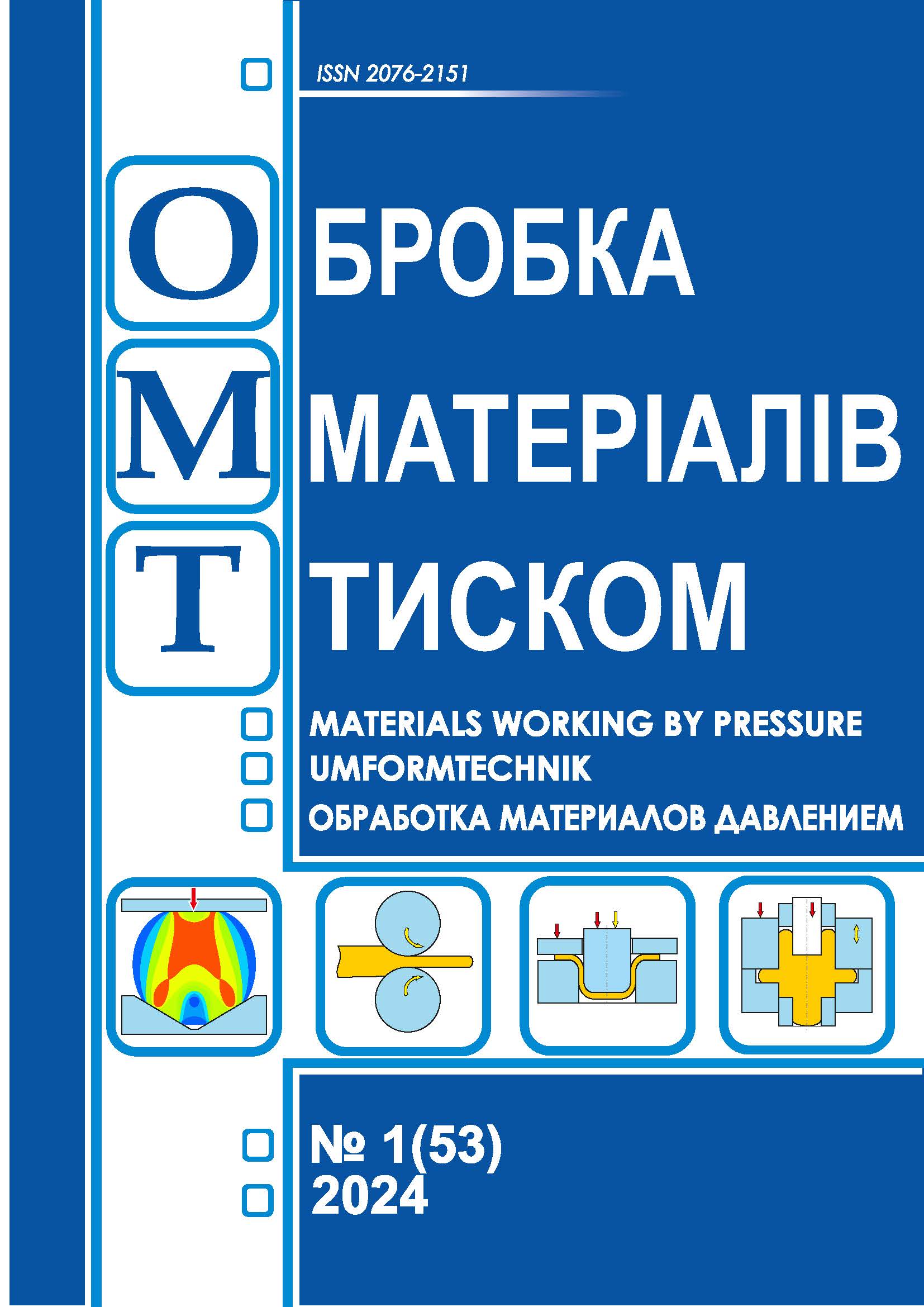Phosphate binders for the manufacture of casting molds in technologies for casting die tool blanks
DOI:
https://doi.org/10.37142/2076-2151/2024-1(53)205Keywords:
die tool, casting, Gibbs energy, binder, alloy steel, phosphoric acid, compressive strength, core mixture, metal sulfates.Abstract
Fedorov M., Liutyi R., Dyachenko Yu., Kocheshkov A., Liuta D.
Phosphate binders for the manufacture of casting molds in technologies for casting die tool blanks
Casting technologies for the production of die tool parts have significant advantages over the use of forgings, rolled bars or powder parts. The steels used for die inserts, dies, punches and other parts generally have satisfactory casting properties and produce precision castings. However, the choice of casting method remains a pressing issue today, since die casting technologies are expensive, energy- and material-intensive. The production of such parts is small-scale, while leading foundry technologies are designed for large series or mass production. An important task is to create technological conditions for the production of work pieces from alloy steels using a minimum amount of materials, which, in turn, are accessible and cheap. Compared to the special casting methods that are used now, casting in one-time molds allows us to solve this problem. At the same time, a new question arises - the creation of effective molding materials suitable for this technology and oriented to the conditions of small-scale production, that is, high-quality and easy-to-use core mixtures. The article presents the results of a study of the processes of formation of binders in systems of orthophosphoric acid with metal sulfates such as MgSO4·7H2O, MnSO4·5H2O, FeSO4·7H2O, CoSO4·7H2O и Al2(SO4)3·18H2O. It has been experimentally established that all of these sulfates, when heated in the range from 150 °C to 300 °C, enter into a chemical interaction with orthophosphoric acid, resulting in hardening of mixtures based on them. Systems with iron and aluminum sulfates have the best performance as binders for core mixtures. For them, the optimal ratios of sulfate and acid, heating temperature and the required binder content in the mixture have been established. Various methods for preparing mixtures have been studied and the feasibility of pre-mixing metal sulfates with orthophosphoric acid to obtain a solution or dry composition has been established. Laboratory tests consisted of using mixtures for casting high-alloy chrome-aluminum steel. The castings do not have burn marks or other surface defects, and therefore the developed core mixtures are potentially suitable for casting alloy steels, including die steels.
References
Bartel G.P., Fedorov N.N., Tupchienko V.I. A promising technology for the manufacture of wear-resistant cast die tools. Materials of the II International Scientific and Practical Conference «Heavy Mechanical En-gineering. Problems and Prospects for Development». Kramatorsk. DSEA. 2004, p. 113. (in Russian).
Minitskyi A.V., Stepanov O.V., Radchuk S.V., Byba Ye.G., Loboda P.I. 3D Printing of Iron-Based Lattice Structures Produced by Selective Laser Melting. Powder Metallurgy and Metal Ceramics. 2022. 61, pp. 189–196. https://doi.org/10.1007/s11106-022-00306-9
Minitsky A. BybaYe., Minitska N., Radchuk S. A study of the structure and properties of materials based on an iron – copper composite powder. Eastern-European Journal of enterprise technologies. 2019. 2/12(98), pp. 44–55. https://doi.org/10.15587/1729-4061.2019.164017
Makarevych O.P., Fedorov G.E., Platonov E.O. Production of castings from special steels. Kyiv: Publish-ing House of NTUU "KPI". 2005. 712 p. (in Ukrainian).
Khilchevsky V.V., Kondratyuk S.E., Stepanenko V.O., Lopatko K.G. Materials science and technology of structural materials: teaching manual. Kyiv: Lybid. 2002. 328 p. (in Ukrainian).
Bokov V.M. Design and manufacture of stamps. Design of stamps: shape-changing, complex action, for assembly and automatic stamping: teaching manual. Kirovohrad: Imex-LTD. 2010. 321 p. (in Ukrainian).
Special methods of casting. Reference book. Ed. V. A. Efimov. Moscow: Mashinostroenie. 1991. 436 p. (in Russian).
Liutyi R.V., Guriya I.M. Formative materials. Textbook. Kiev: I. Sikorskyi KPI. 2020. 257 р. (in Ukrain-ian).
Fedorov N.N. Methodological aspects of determining the properties of bentonite molding clays. Casting and Metallurgy. 2014. 4 (77), pp. 19–23. (in Russian).
Fedorov N.N. Additive method of changing the properties of bentonite molding clay. Herald of the Donbass State Engineering Academy. 2010. 3(20), pp. 249–253. (in Russian).
Ponomarenko O.I., Karateev A.M., Evtushenko N.S., Berezhnaya A.V. The use of OPOS resin in found-ry production. Casting Processes. 2010. 6 (84), pp. 27–32. (in Russian).
Evtushenko N.S., Shinskii O.I., Ponomarenko O.I. Study of the properties of regenerated mixtures based on OFOS. Compressor and Power Engineering. 2013. 4(34), pp. 48–51. (in Russian).
Berlizeva T.V., Ponomarenko O.I., Kachanova N.A. Modeling the properties of CTS based on chromite sand and cyclocarbonates. Compressor and Power Engineering. 2015. 1(39), pp. 48–51. (in Russian).
Doroshenko S.P. Molding mixtures. Kyiv: ІZМN. 1997. 140 p. (in Ukrainian).
Liutyi R., Liuta D., Petryk I. Structural construction of binders based on orthophosphoric acid and re-fractory materials. Advances in Materials Science and Engineering. 2021. https://doi.org/10.1155/2021/6667769
Keush D.V. Patterns of the formation of binders from phosphoric acid and refractory fillers. Casting Processes. 2015. 4 (112), pp. 40-46. (in Russian).
Liutyi R., Tyshkovets M., Liuta D. Foundry core mixtures with orthophosphoric acid and different alu-minum-containing compounds. Physics and Chemistry of Solid State. 2020. 21, pp. 176–184. https://doi.org/10.15330/pcss.21.1.176-184
Liutyi R.V., Fedorov M.M., Dyachenko Yu.G., Kocheshkov A.S., Demchuk G.V., Liutа D.V. Technolog-ical properties of rod mixtures with phosphates of aluminum, zirconium and silicon for the production of cast blanks of stamping tools. Materials Working by Pressure. Kramatorsk: DSEA. 2023. 1(52), pp. 207–215. https://doi.org/10.37142/2076-2151/2023-1(52)207 (in Ukrainian).
Evstigneev A.I., Dmitriev E.A., Saygushkina V.A. Core mixture with sulfate binder. Foundry produc-tion. 2014. 8, pp.11-12. (in Russian).
Liutyi R.V., Guriya I.M., Shapovalova D.V., Keush D.V. Formation of binder compositions in molding mixtures based on orthophosphoric acid and metal salts. Foundry production. 2013. 5, pp. 16–19. (in Russian).

